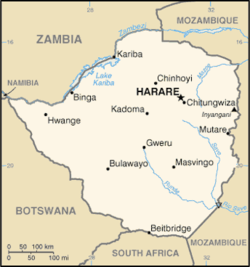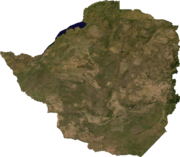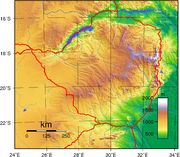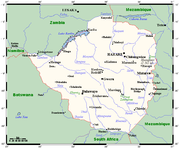
Geography of Zimbabwe
About this schools Wikipedia selection
SOS Children has tried to make Wikipedia content more accessible by this schools selection. A good way to help other children is by sponsoring a child
| Geography of Zimbabwe | |
 |
|
| Continent | Africa |
| Region | Southern Africa |
| Coordinates | 20°S 30°E Coordinates: 20°S 30°E |
| Area | Ranked 67th 390,757 km2 |
| Coastline | 0 km (landlocked) |
| Borders | 3,066 km (Botswana 813 km, Mozambique 1231 km, South Africa 225 km, Zambia 797 km) |
| Highest point | Inyangani 2,592 m |
| Lowest point | junction of the Runde and Save rivers. 162 m |
| Longest river | Zambezi River 2,650 km |
| Largest lake | Lake Kariba 7,770 km2 |
Zimbabwe is a landlocked country in southern Africa lying wholly within the tropics. It straddles an extensive high inland plateau that drops northwards to the Zambezi valley where the border with Zambia is and similarly drops southwards to the Limpopo valley and the border with South Africa. The country has borders with Botswana 813 km, Mozambique 1,231 km, South Africa 225 km, Zambia 797 km and meets Namibia at its westernmost point.
Area
It is the 59th largest country in the world (although below average size for Africa) just larger than Japan or Montana but smaller than Paraguay, with a total area of 390,580 km², of which 3,910 km² comprises lakes and reservoirs.
Climate
The climate is tropical, although markedly moderated by altitude. There is a dry season, including a short cold season during the period May to September when the whole country has very little rain. The rainy season is typically a time of heavy rainfall from November to March. The whole country is influenced by the Intertropical Convergence Zone during January. In years when it is poorly defined, then there is below average rainfall and a likelihood of serious drought in the country (as happened in 1983 and 1992). When it is well-defined then rainfall is average or well above average, as in 1981 and 1985.
Terrain
Much of the country is high plateau with higher central plateau (high veld) forming a watershed between the Zambezi and Limpopo river systems. The Limpopo and the lower Zambezi valleys are broad and relatively flat plains. The eastern end of the watershed terminates in a north-south mountain spine, called the Eastern Highlands.
Elevation extremes:
lowest point: junction of the Runde and Save rivers 162 m
highest point: Mount Nyangani 2,592 m
Natural resources: coal, chromium ore, asbestos, gold, nickel, copper, iron ore, vanadium, lithium, tin, platinum group metals
Land use:
arable land: 8.24% (2005)
permanent crops: 0.33% (2005)
other: 91.43% (2005)
Irrigated land: 1,740 km² (2003)
Natural hazards: recurring droughts; floods and severe storms are rare
Environment - current issues: deforestation; soil erosion; land degradation; air and water pollution; the black rhinoceros herd - once the largest concentration of the species in the world - has been significantly reduced by poaching; poor mining practices have led to toxic waste and heavy metal pollution
Environment - international agreements: party to: Biodiversity, Climate Change, Desertification, Endangered Species, Law of the Sea, Ozone Layer Protection signed, but not ratified: none of the selected agreements
Hydrology: The country is divided into six drainage basins. The largest are the Zambezi and the Limpopo. Western parts of Matabelelandconnect to the Okavango inland drainage basin through the Nata river. Most of the southern Mashonaland and adjacent parts of Masvingo drain through the Save river into the Indian ocean. Two smaller drainage basins cover parts of Manicaland, and drain into the Indian Ocean through Mozambique. These are the Pungwe river to the north and the Buzi river to the south. Sediment transport has been studied for rivers in Zimbabwe using the HBV hydrology transport model.
Table 1.
Rainfall and land use suitability options in Zimbabwe's natural regions Natural region Rainfall Main land use type
1 Above 1050 mm/annum with some precipitation in all months of the year Afforestation, fruit, tea, coffee and intensive livestock production
2 750–1000 mm/annum seasonally confined with well-defined dry season Large scale intensive crop and livestock production
3 650–800 mm/annum with regular mid-season dry spells Livestock production with fodder crops. Marginal production of maize, tobacco and cotton
4 450-650 mm/annum with periodic seasonal drought and severe rainy season dry spells Livestock production and drought resistant crops
5 Too low and erratic for even drought resistant fodder and grain crops Extensive livestock and/or game ranching
Source: CSO (1997, 144).



